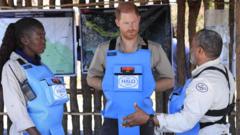Is Santa's Village in the Arctic Circle Warmer Than the UK Today?

Understanding the Heatwave Phenomenon in Finland and Beyond
As the climate continues to change, regions that were once characterized by moderate weather patterns are experiencing surprising shifts. Finland, a country known for its crisp, cool temperatures, is now witnessing heatwaves that challenge its historical climate norms. In this article, we will delve into the factors contributing to these rising temperatures in Finland, the implications for its natural ecosystems, and the broader context of climate change that affects not just Finland but also the entire globe.
The Rising Temperatures: A Closer Look
Contrary to what many might expect after a vacation in warmer regions, returning to Finland has become synonymous with experiencing similar sweltering heat. This shift is evidenced by the record-breaking temperatures that have been reported. For instance, a recent summer saw temperatures soar to unprecedented levels, with averages that hadn't been recorded since 1937. The persistence of high temperatures, reaching up to 32.4°C, has left many residents baffled and concerned.
What Triggers a Heatwave in Finland?
In Finland, a heatwave is officially declared when daily average temperatures reach 20°C or when daily highs exceed 27°C. The meteorological office has issued warnings for various regions, indicating the seriousness of the situation. Here are some factors contributing to the heatwave phenomenon:
- Geographical Changes: With its position within the Arctic Circle, Finland has historically enjoyed cooler summers. However, global warming has altered this landscape, leading to unexpected weather patterns.
- Climate Change: It’s no secret that climate change is driving extreme weather across the globe. Finland's rising temperatures are a local manifestation of a worldwide crisis.
- Urban Heat Islands: Urbanization can exacerbate heatwaves. Cities tend to retain heat, making surrounding areas warmer during extreme weather events.
The Impact of Heatwaves on Finland’s Ecosystem
Heatwaves pose significant risks to Finland's unique ecosystems, which have evolved under relatively stable climatic conditions. The following areas are particularly vulnerable:
1. Flora and Fauna
The natural habitats in Finland support diverse species, and an abrupt change in temperature can disrupt breeding cycles, feeding patterns, and migratory routes. For example:
- Forests: Increased temperatures can stress trees, making them more susceptible to pests and diseases.
- Wildlife: Animals may struggle to adapt their behavior to cope with the heat, affecting their survival rates.
2. Water Resources
With rising temperatures, water bodies may experience reduced levels due to evaporation. This decline affects not only aquatic life but also human activities that rely on these resources:
- Fishing: Changes in water temperature can lead to shifts in fish populations, affecting local fisheries.
- Recreation: Lakes and rivers that are vital for recreational activities may experience lower water levels, impacting tourism.
3. Agriculture
Farmers in Finland are also feeling the heat, as extreme weather patterns can lead to crop failures. The agricultural sector is grappling with:
- Heat Stress: Crops that thrive in cooler climates may not survive prolonged heat, leading to lower yields.
- Water Shortages: With less rainfall and higher evaporation rates, irrigation becomes crucial, but not all farmers can adapt quickly.
The Societal Implications of Heatwaves
The impact of heatwaves extends beyond environmental concerns; they also pose challenges to human health and infrastructure. As Finland grapples with increasing temperatures, the following societal implications emerge:
1. Public Health Risks
Heatwaves can exacerbate existing health problems and create new public health challenges. Vulnerable populations, such as the elderly and those with pre-existing conditions, are at higher risk of:
- Heat Exhaustion: Prolonged exposure to high temperatures can lead to heat exhaustion, requiring medical attention.
- Respiratory Issues: High temperatures can worsen air quality, leading to respiratory problems among sensitive groups.
2. Infrastructure Strain
Extreme heat can put a strain on infrastructure, including:
- Power Supply: Increased demand for cooling can lead to power outages.
- Transportation: Roads and railways may suffer damage due to heat, causing disruptions in transportation services.
3. Economic Challenges
As different sectors struggle to cope with rising temperatures, the economic ramifications can be significant. Potential challenges include:
- Increased Costs: Cooling solutions for homes and businesses become necessary, raising energy costs.
- Tourism Impact: While some might flock to Finland for summer heat, others may avoid it due to extreme conditions.
Comparing Finland's Climate to Other Regions
While Finland is experiencing unusual heat, it is important to contextualize this within the broader climate landscape. For example:
1. The UK’s Heat Experience
Although the UK is not currently in a heatwave, it has experienced several back-to-back heatwaves over the past years. The proximity to the equator allows for warmer temperatures, making the UK generally warmer than Finland. This comparison highlights:
- Regional Variability: Different regions have unique climate characteristics influenced by geographic and meteorological factors.
- Adaptation Needs: Countries like Finland must adapt to changing climates in a way that countries with historically warmer climates have already begun to do.
2. Global Comparisons
Finland’s current climatic changes can be seen as part of a larger global trend. Extreme weather patterns are becoming increasingly common worldwide, with various regions experiencing their own unique challenges:
- Heatwaves in North America: Similar to Finland, North America is facing unprecedented heat that is leading to droughts and wildfires.
- Flooding in Asia: While some areas are suffering from heat, others are grappling with heavy rainfall and flooding, showcasing the erratic nature of climate change.
Strategies for Coping with Heatwaves
As the frequency of heatwaves increases, it is imperative for individuals, communities, and governments to develop strategies to cope with these extreme conditions. Here are some effective methods:
1. Community Awareness and Preparedness
Raising awareness about the risks associated with heatwaves is crucial. Communities can:
- Educate Residents: Provide information about recognizing heat-related illnesses and how to stay cool.
- Emergency Plans: Establish community emergency plans that include cooling centers and transportation for vulnerable populations.
2. Infrastructure Improvements
Investing in infrastructure that can withstand extreme heat is essential. This includes:
- Green Spaces: Creating more parks and green areas can help cool urban environments.
- Efficient Energy Solutions: Investing in renewable energy sources can reduce dependency on fossil fuels, which contribute to climate change.
3. Sustainable Practices
Adopting sustainable practices can mitigate the effects of climate change, including:
- Water Conservation: Implementing water-saving technologies can help manage resources during heatwaves.
- Support for Local Agriculture: Promoting local farmers can create a resilient food system less affected by extreme weather.
Conclusion
The heatwaves sweeping through Finland serve as a stark reminder of the changing climate and the urgent need for adaptation strategies. As temperatures rise, it is essential to comprehend the implications not only for Finland’s environment but also for its people, economy, and infrastructure. The interplay between climate change and local weather patterns highlights the critical need for collective action to combat this global challenge. As we face these unprecedented conditions, one must reflect on how we can contribute to a more sustainable future.
FAQs
What causes heatwaves in Finland?
Heatwaves in Finland are caused by a combination of factors, including climate change, geographical shifts, and urbanization. The country is experiencing rising temperatures due to global warming, which disrupts historical weather patterns.
How can I stay safe during a heatwave in Finland?
To stay safe during a heatwave, stay hydrated, avoid outdoor activities during peak sunlight hours, and seek cool places. If you are vulnerable, consider staying with friends or family who have air conditioning.
What are the long-term effects of heatwaves on Finland's environment?
Long-term effects of heatwaves on Finland's environment may include changes in biodiversity, water shortages, stressed agricultural systems, and increased vulnerability to pests and diseases in flora and fauna.
As we navigate the complexities of climate change, what steps do you think we should take to prepare for future heatwaves and protect our environment? #ClimateChange #Heatwave #Sustainability
Published: 2025-07-16 13:54:23 | Category: News



